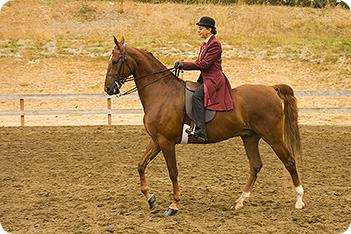
Horseback Riding
Riding on Horse Back
From: Equestrian and Horse
See also: Mounting | Position | Lunging | Flatwork
Jumping | Dismounting

Horseback Riding
All aspects of horse back riding need careful attention, and as with many things, good foundation skills are the basis for fast development.
Whether riding in the classical English style, or the more relaxed Western style, similar rules apply.
Mounting
Knowing how to get your horse ready for mounting, as well as how to mount correctly, are essential for the safety of your horse, and the safety of you, the rider.
More about Mounting a Horse
Position
There are different positions for different activities, whether you are riding dressage, jumping the horse, or riding western style, the main thing is to have a secure position that keeps you in balance, and control of the horse at all times.
Knowing how to hold the reins, and how high your hands should be held, how to sit in the saddle, where your leg should be, and where you should be looking, are all part of progressing towards a sound and secure position, whatever activity you are participating in.
More about Riding Position
The Riders Aids
Rider aids are what the rider uses to communicate set commands to the horse, such as movements like halt, bend, and move off.
Learning all the different aids will allow you to isolate different areas of the horse and therefore have far more control.
Understanding what you do and how it affects your horse comes down to having a good riding position and how you use it.
More About Rider Aids
Horseback Riding Terminology
There are many technical terms used in the art of dressage and all forms of horseback riding, being able to understand them can only help to improve your riding and also help you to understand and improve your horses way of going.
More About Horseback Riding Terminology
Flatwork
This is where the rider uses different leg, hand and seat aids to perform different movements, changes of rein and transitions.
Movements can be lateral in nature, which is where the horse is asked to move forwards and sideways at the same time, such as when riding half pass or leg yield.
All flatwork exercises should be done equally on both reins (ie left/right turn equally) and many exercises can be done in walk, trot and canter.
Flatwork encourages the horse to listen to the rider's aids and become more attentive to the rider, and also encourages the horse to use it's body properly, by using the correct muscles and staying in rhythm and balance.
More about Flatwork Riding
Jumping
Taking a horse over an obstacle takes great skill to be done properly.
If you are jumping a show jump pole or a cross country log, for example, the basic principles are the same.
Knowing your seven stages of 1) good turn, 2) approach, 3) take off, 4) jump, 5) landing, 6) get away, and 7) turn, will help you to achieve a well balanced jump that is fun, comfortable, and safe for both you and your horse.
Being aware of your surroundings and ground conditions and the different types of fences, and how to jump them, are all aspects of jumping that need to be considered to gain a successful and safe jump.
More about Jumping Horses
Dismounting
When you are ready to dismount, following the correct dismounting procedure will help you to know where and how to dismount safely, and still remain in control of your horse at all times. This makes it safer for both you and your horse, and passers by.
More about Dismounting